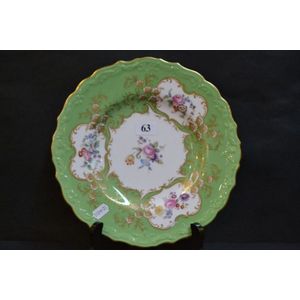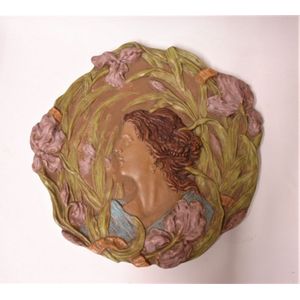Hand-painted Royal Doulton plate with yellow roses
You must be a subscriber, and be logged in to view price and dealer details.
Subscribe Now to view actual auction price for this item
When you subscribe, you have the option of setting the currency in which to display prices to $Au, $US, $NZ or Stg.
- Gilding - Gilding is a method of ornamentation whereby a thin sheet of gold metal is applied to items made of wood, leather, ceramics, glass and silver for decorative purposes.
For furniture including mirrors, the sheet of gold is usually applied over a coating of gesso. Gesso is a mixture of plaster of Paris and gypsum mixed with water and then applied to the carved wooden frames of mirrors and picture frames as a base for applying the gold leaf. After numerous coats of gesso have been applied, allowed to dry and then sanded a coat of "bole", a usually red coloured mixture of clay and glue is brushed on and allowed to dry, after which the gold leaf is applied. Over time parts of the gilding will rub off so the base colour can be seen. In water gilding, this was generally a blue colour, while in oil gilding, the under layer was often yellow. In Victorian times, gilders frequently used red as a pigment beneath the gold leaf.
Metal was often gilded by a process known as fire gilding. Gold mixed with mercury was applied and heated, causing the mercury to evaporate, the long-term effect of which was to kill or disable the craftsman or woman from mercury poisoning. The pursuit of beauty has claimed many victims, not the least of which were the artists who made those pieces so highly sought after today. - Bone China - Bone china, Also called 'English china", is one of the three types of porcelain, the other two being soft paste porcelain and hard paste porcelain.
Porcelain is an ancient ceramic material, first made in China, hence the common name "china", and the introduction of bone china was to counter the imports of Chinese porcelain.
The initial development of bone china is credited to Josiah Spode, who introduced it around 1800 and it was soon after copied by other manufacturers including Minton, Coalport, Davenport, Derby, Worcester, Wedgwood and Rockingham and the Herculaneum factory at Liverpool.
Spode's bone china was made by mixing ash from cattle bones with feldspar and kaolin, which created a material that was stronger, more translucent, and whiter than traditional porcelain. He began to produce this new type of porcelain in 1796 and it quickly became very popular.
At the time, the process and ingredients were kept secret and were only known to a few manufacturers and were protected by patents.
In the 19th century, bone china became increasingly popular and was widely produced by many manufacturers in England. During this time, it was considered a luxury item and was often used to create fine dining sets and other decorative items.
Bone china is still used in the production of fine porcelain wares, such as tea sets, figurines, and other decorative pieces. His basic formula of six parts bone ash, four parts china stone, and three and a half parts china clay remains the standard English body. It is still considered a luxury item due to its strength, translucency, and whiteness, and is often used for high-end and high-quality porcelain. China.
This item has been included into following indexes:
Visually similar items

Spode Copeland plate, green ground

Two ceramic floral bouquets, one Crown Staffordshire, the other Denton

An Art Nouveau Austrian terracotta portrait plaque by Ernst Wahliss (1837-1900), relief moulded with the portrait in profile of a young maiden framed by sinuous flowering irises, matt painted in tones of lilac, browns and green, the reverse with impressed

A Chelsea porcelain dessert stand, circa 1760 the oval dish modelled with a basket border with naturalistic vine handles to either end, with a brown rim, painted in colours with insects and butterflies amongst vine leaves and grapes, unmarked 27 cm wide, 2
